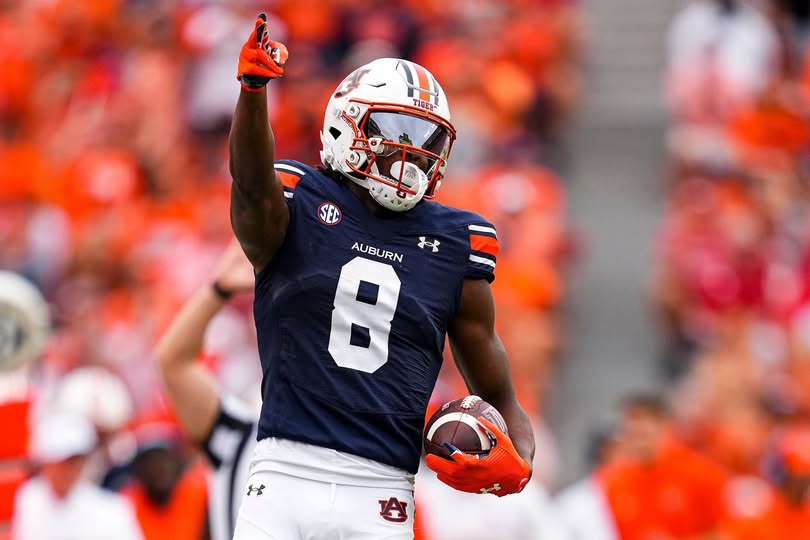
Auburn football is facing an unusual off-season reality: the program will enter the 2025 season without its leading rusher from the previous campaign. This marks the first time since 2020—when Tank Bigsby graduated—that the Tigers have not retained their top ground-game producer. That continuity had shaped Auburn’s offensive identity across the last four seasons, and its absence now sets the stage for a pivotal and potentially transformative year. The loss of a premier running back represents both a challenge and an opportunity, stirring questions about who will step forward and how the team will chart its path in the Southeastern Conference.
When Jarquez Hunter emerged in 2023, he quickly grabbed the mantle from Bigsby. His breakout season—culminating in over 900 rushing yards and seven touchdowns—hinted at greater possibilities. That potential was fully realized in the 2024 campaign. Hunter eclipsed the 1,200-yard mark, consistently delivering high-caliber performances in key matchups and solidifying himself as the featured back in coach Hugh Freeze’s offense. His departure now leaves an undeniable void, not merely in statistics, but in the fabric of Auburn’s identity. From 2021 through 2024, the Tigers relied on a bell cow back who provided a steady, effective presence on the ground, which shaped the offense’s rhythm and balance. Hunter’s exit after the 2024 season ends that consistent thread for the first time in five years.
This absence forces Auburn to reconsider its offensive blueprint. With Hunter gone, the question is no longer who can serve as the featured back, but rather who can rise to the same level of production and leadership. A lineup of returning backs, each with distinct strengths, now compete for the role. Damari Alston enters primed for an expanded role. In 2023, he averaged an impressive 5.7 yards per carry on a limited workload, flashing power and vision. His performances in high-stakes games—such as the Iron Bowl—suggest an ability to shoulder greater responsibility. But can he sustain that level of production across an entire season?
There is also Jeremiah Cobb: a sophomore with burst and breakaway speed but limited experience. In glimpses on the field, he produced explosive plays that hint at untapped potential. The challenge facing him is twofold: earning trust in game scenarios and maintaining consistency. For Cobb to anchor Auburn’s backfield, he must grow into a comprehensive rusher rather than sporadic threat.
Brian Battie brings another dimension to the competition. A former USF standout who topped 1,100 rushing yards in 2022, Battie arrived at Auburn with expectations of dominance. Health issues limited his 2023 production, but the flashes he offered—both in the run game and on special teams—were compelling. He has the agility and vision to excel, but durability and adaptation to the SEC level will define his trajectory.
Sean Jackson, too, looms as an intriguing wild card. With just six carries in 2023, his average yards per carry were off the charts—though the sample size was small. His explosive potential suggests he could be the team’s home-run threat on jet sweeps or outside-zone plays, especially in a situational role. With so many candidates returning, it feels like a true competition, with no clear favorite.
Yet the Tigers aren’t strictly limited to returning players. The team may look to supplement the depth chart via the portal or the recruiting class, though no major additions were made to the running back room in 2024. That could change, of course, as spring and early summer moves often precede the fall camp. A well-timed transfer could tip the balance in this wide-open race.
As the candidates compete, the underlying structure of the offense will serve as a litmus test. Freeze and his staff have built a balanced attack that relies on a productive ground game to open up play-action, maintain clock control, and wear down defenses in SEC play. Losing last season’s leader demands that the system flex to new strengths while preserving the traits that made it effective. Whether that means leaning more on multiple viable backs, adjusting play-calling, or emphasizing tempo and spread concepts remains to be seen.
A deeper rotation could translate into more explosive plays, as defenders can’t key on a single back. Auburn could also diversify by using jet sweeps, screens, or RPO variations to take advantage of speed and agility. In this sense, the lack of a lone featured back may actually help the offense become more dynamic. Yet the risk is clear: without someone capable of delivering 100-yard games consistently, Auburn could struggle to impose its will in crucial moments. Big games—against the likes of Georgia, LSU, or Florida—often come down to who controls the ground game. If Auburn enters matchups without a proven leader in the backfield, it could compromise its competitive ceiling.
The offensive line’s performance will be critical. Regardless of the player in the backfield, run blocking remains essential. If the line holds its own, whoever wins the job could produce well. But any regression up front might expose the rotation as unstable or trendless. It will be Freeze’s responsibility to balance continuity with experimentation—to offer opportunities while setting a singular identity.
Offseason focus will likely center on how reps are allocated during practice and spring ball. Watch for attention on who begins wearing No. 1 in camp, who consistently hits the hole hardest in drills, and who makes decisive cuts at full speed. Early carries in fall scrimmages will matter. Freeze may give the nod to a single back before fall camp ends or continue rotating until a closer emerges.
The emotional and psychological element of this transition should not be overlooked. Hunter was not only productive on the field; he was a leader in the locker room. Leadership still matters, and someone needs to fill that role if Auburn’s rushing game is to feature both consistency and accountability. Alston and Battie, evidently mature and experienced, could step into that void. But an emotional leader who sets the tone in pass protection, in goal-line situations, and off the field could solidify a run game that still needs a face.
From a broader team perspective, the absence of a returning top rusher is an inflection point. Auburn must either prove that its offense is more than the sum of one player or that it can discover a new one to rally around. The SEC East remains a gauntlet, and seasons do not wait for confidence to build. Auburn’s identity will be tested early. With expectations high under Freeze’s leadership, questions loom: Will the Tigers slot into a hot-handed committee rotation and thrive on unpredictability or will the running game sputter as they search for direction?
The fanbase, energized but watchful, offers a window into the prevailing sentiment. In forums and message boards, supporters express cautious optimism about the returning group, with many pointing to Alston’s reliability, Cobb’s upside, and Battie’s proven talent. Yet obscurity still hovers—with no prior full season of sustained dominance among them, the question is not only who will perform, but who will take ownership. Auburn faithful crave a back they can rally behind.
Internally, the locker room dynamic will reveal much. The depth group must coalesce around whoever emerges, absorbing the team-wide importance of the role. Freshmen may begin the season bursting for reps, but unless they become standout performers, they’ll likely wait their turn. Regardless, the competition itself can become a catalyst for improvement—provided it remains constructive rather than chaotic.
Ultimately, the next Auburn star may arrive under less fanfare than predecessors, but no less impactfully. This season presents the opportunity for a dynamic, multi-dimensional ground attack that could become more formidable than a one-man show. Alternatively, without the right player stepping forward, Auburn risks diminishing its offensive identity and will struggle to make noise in key conference games.
The narrative here goes beyond simple production. It’s a test of the system’s resilience and Freeze’s adaptability. The Tigers must synthesize strategy and execution, balancing backups against breakouts, loading the rotation with power yet peppering it with speed. The offensive line’s cohesion, the backfield’s chemistry, and the coaching staff’s decisions will all converge to determine whether Auburn shapes a new rushing identity or sees its momentum stall.
For college football—and the SEC in particular—no team loses a lead back without scrutiny. Auburn is a case study in modern evolution. Should its running game change dramatically without missing a beat, it will serve notice that the Tigers belong among the divisional elite. But if the transition produces inconsistency, that 2025 season could serve as a cautionary tale.
What remains clear is this: Auburn football has reached a departure point. The days of last season’s feature back are over. Now dawns a new chapter—one where a fresh player must dawn prominence or the lights of controversy will shine. The next leader in the Tigers’ backfield will carry more than the ball. He carries the weight of history and expectation. For any young running back eager to seize the role, the stage is set. For Auburn fans, the question is no longer whether the next back can fill the statistical void; it is whether he can redefine it entirely.
In football, as in life, change can either diminish or elevate. Auburn—in seeking direction and identity following the end of a remarkable run—stands at such a threshold. The coming months and games will reveal not just the stats, but the story: of emergence, leadership, and a team’s determination not to merely replace a player, but to transcend the moment.





